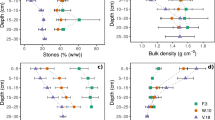Abstract
Purpose
In Berlin and many other cities, technogenic soil substrates from World War II and building and construction debris, in general, play an important role for soil formation and solute transport in the vadose zone. The largest debris landfill in Berlin is the Teufelsberg. Sulfate release from the landfill poses threats to groundwater quality. The scope of this study is to determine and model the processes controlling sulfate release from soils containing construction rubble.
Materials and methods
Column leaching experiments were conducted to analyze sulfate mobilization from Teufelsberg topsoil material. Flow interruptions of 1 and 7 days were applied. Sulfate release was modeled using a geochemical simulation tool (HP1). The model considered water flux, solute transport, and precipitation/dissolution with first-order kinetics.
Results and discussion
Sulfate release increased after flow interruptions, although bromide breakthrough indicated physical equilibrium of transport processes. Hence, kinetically limited solution/dissolution of sulfate is assumed. The model was applicable for qualitative description of our experimental results. The estimated equilibrium concentrations of sulfate were one to two orders of magnitude smaller than expected according to the equilibrium constant of gypsum.
Conclusions
It is assumed that the mobilization and transport of sulfate from debris soil material can be described by an effective model. If sulfate release and transport from soils containing debris is modeled using literature values of thermodynamic constants for gypsum, sulfate concentrations will be overestimated by one to two orders of magnitude.










Similar content being viewed by others
References
Al-Barrak K, Rowell D (2006) The solubility of gypsum in calcareous soils. Geoderma 136(3):830–837
Bock E (1961) On the solubility of anhydrous calcium sulfate and of gypsum in concentrated solutions of sodium chloride at 25 °C, 30 °C, 40 °C, and 50 °C. Can J Chem Eng 39(9):1746–1751
Davies C (1962) Ion association. Vol. 30. Butterworths, London
EU directive for drinking water (1998) Council directive 98/83/EC of 3 November 1998 on the quality of water intended for human consumption
Fugro Consult GmbH (2006) Qualität des oberflächennahen Grundwassers. Senatsverwaltung für Stadtentwicklung und Umweltschutz, Berlin
Heizer WD, Sandler RS, Seal E Jr, Murray SC, Busby M, Schliebe BG, Pusek SN (1997) Intestinal effects of sulfate in drinking water on normal human subjects. Dig Dis Sci 42(5):1055–1061
Jacques D, Šimůnek J (2005) User manual of the multicomponent variably-saturated flow and transport model HP1, description, verification and examples, version 1.0, SCK•CEN-BLG-998, Waste and Disposal, SCK•CEN, Mol, Belgium, 79 pp
Jang YC, Townsend T (2001) Sulfate leaching from recovered construction and demolition debris fines. Adv Environ Res 5:203–217
Jang YC, Townsend T (2003) Effect of waste depth on leachate quality from laboratory construction and demolition debris landfills. Environ Eng Sci 20(3):183–196
Keren R, Kauschansky P (1981) Coating of calcium carbonate on gypsum particle surfaces. Soil Sci Soc Am J 45(6):1242–1244
Kuechler R, Noack K, Zorn T (2004) Investigation of gypsum dissolution under saturated and unsaturated water conditions. Ecol Model 176(1–2):1–14
Lahr J, Lucka M, Zanoth S (2007) Diplomkartierung—Stoffbestand und physikalische Eigenschaften von Trümmeraufschüttungen in Berlin. Technische Universität Berlin, Berlin
Lindsay WL (1979) Chemical equilibria in soils. Blackburn, Caldwell
Nehls T, Rokia S, Mekiffer B, Schwartz C, Wessolek G (2012) Contribution of bricks to urban soil properties. J Soils Sediments. doi:10.1007/s11368-012-0559-0
Nissing W (2004) Korrosion und Korrosionsschutz in Wasseraufbereitungsanlagen, in: Wasseraufbereitung—Grundlagen und Verfahren. Oldenbourg Industrieverlag, München
Stumm W, Morgan JJ (1996) Aquatic chemistry—chemical equilibria and rates in natural waters. Wiley, New York
Sudmalis M, Sheikholeslami R (2000) Coprecipitation of CaCO3 and CaSO4. Can J Chem Eng 78(1):21–31
Toride, N, Leij FJ, van Genuchten MT (1995) The CXTFIT code for estimating transport parameters from laboratory or field tracer experiments. Version 2.0, Research Report No. 137, US Salinity Laboratory, USDA, ARS, Riverside, CA
Wisotzky F (2011) Angewandte Grundwasserchemie, Hydrogeologie und hydrogeochemische Modellierung—Grundlagen, Anwendungen und Problemlösungen. Springer, Heidelberg Dordrecht London New York
World Health Organization (2011) Guidelines for drinking-water quality; 4th edition
Acknowledgments
We thank Christine Ehrlicher, Andreas, and Till for hours spent in the lab and Dr. Enrico Hamann for great help with the chemical model. We thank the reviewers for profound discussions on the applicability of numerical modeling and the Deutsche Forschungsgesellschaft (WE 1125/26-1) for funding.
Author information
Authors and Affiliations
Corresponding author
Additional information
Responsible editor: Jean Louis Morel
Rights and permissions
About this article
Cite this article
Schonsky, H., Peters, A., Lang, F. et al. Sulfate transport and release in technogenic soil substrates: experiments and numerical modeling. J Soils Sediments 13, 606–615 (2013). https://doi.org/10.1007/s11368-012-0615-9
Received:
Accepted:
Published:
Issue Date:
DOI: https://doi.org/10.1007/s11368-012-0615-9




